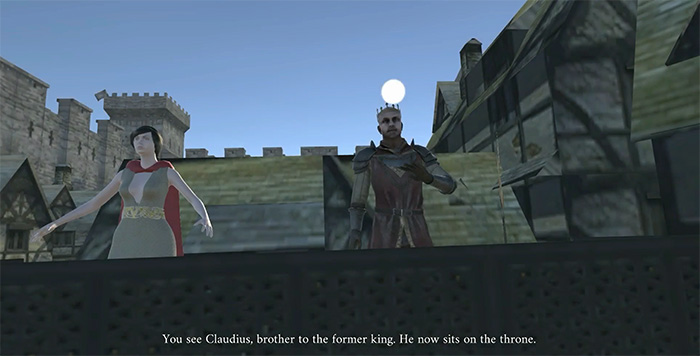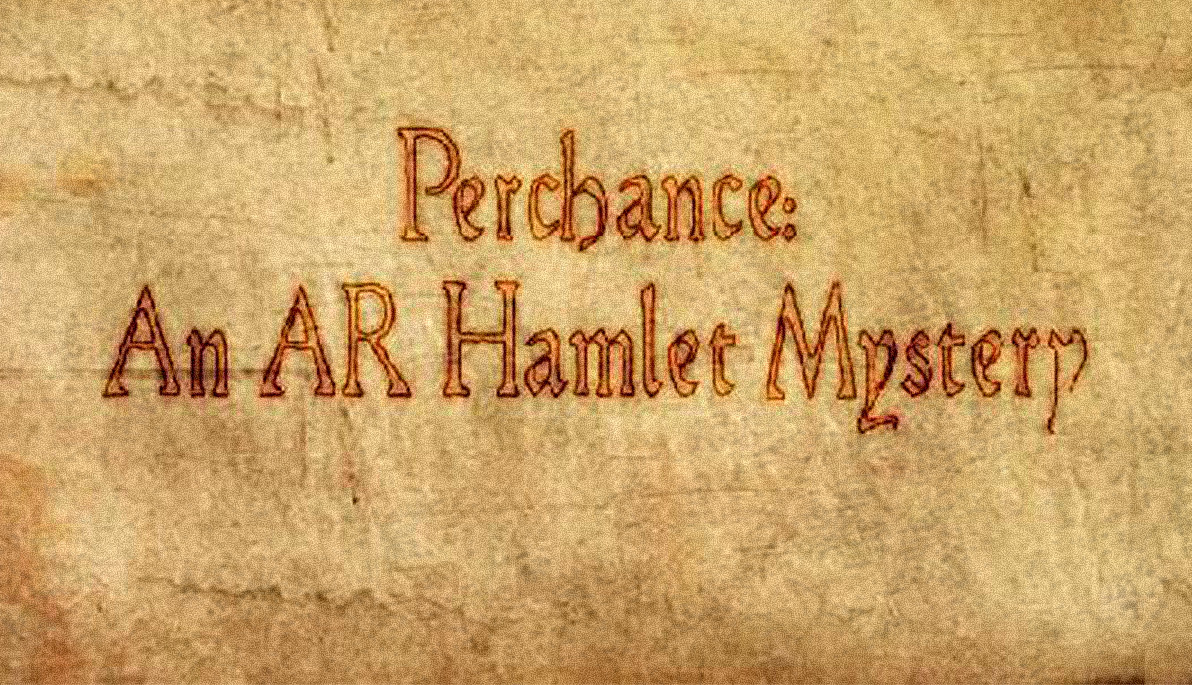News
Mixed Reality Game Brings 16th-Century Literature to the Modern Age
April 23, 2021
How do you make 500-year-old literature enticing to today’s college student? The method used by one New York Tech professor may surprise you.
John Misak, D.A., assistant professor of English, is using video games, augmented reality (AR), and virtual reality (VR) to bring 16th-century Shakespearean literature into the modern age. The interactive nature of these technologies complements the more traditional study of popular works of literature and cinema in his writing classes.
In fact, Misak has been using video games in the classroom for years, but recently he’s taken his approach a step further—he’s now creating them.
Perchance: An AR Hamlet Mystery is a video game designed by Misak and fellow College of Arts and Sciences faculty member Kevin LaGrandeur, Ph.D. It provides New York Tech students with an in-depth experience of Shakespeare’s Hamlet while also enhancing their comprehension and retention.
21st-Century Solutions
While Hamlet is ubiquitously listed as required reading at colleges and universities in the United States, for many students, reading complex Shakespearean English can seem like deciphering a tedious, ancient language. They may struggle to initially follow along and gloss over some of the text, causing them to miss key contexts. This can leave students disconnected from the story, resulting in a lack of classroom engagement. Some educators even rely on students to read the dialogue of a character or enact the play in front of the class, which could also prevent shyer students from enjoying the experience.
Perchance offers an engaging solution. The cutting-edge AR/3-D game immerses students in the story by enabling them to “walk” around the castle where Hamlet meets his father’s ghost. By focusing on specific elements of the play, particularly the scenes in which the ghost appears, students see what the character would see in that given moment. By experiencing the story firsthand, they can visualize key events while forging their own connections and memories with the play. This allows them to form a conclusion to the story’s central question: is the ghost real or a product of Hamlet’s mindset?

The cutting-edge AR/3-D game immerses students in the story by enabling them to “walk” around the castle.
“I see our work as a balance between traditional and cutting-edge technology. Our app is designed to encourage reading—not replace it,” says Misak.
Studies on video games and memory retention also support this complementary approach. These sensory experiences can stimulate the hippocampus, the region of the brain responsible for the formation and storage of new memories, which allows users to form stronger connections to the environment and events within a game’s story. The hippocampus also helps to attach sensations and emotions to these memories, which is one reason why students may be more likely to remember scenes if they experience them for themselves.
From Concept to Game
The game’s development began in 2017 when Misak noticed that some students felt somewhat disconnected from Hamlet. Many students had preconceived notions about the play, believing that it was difficult to read and unappealing, leading them to avoid the reading. Polling indicated the majority of students did not read Hamlet when assigned. Research showed that both students and faculty felt undergraduates were unprepared to experience Shakespeare.
“We saw an opportunity to create a high-impact classroom exercise. Having theorized based on student sentiment toward Shakespeare, it was time to put our thoughts into practice. Perchance is the result of this desire to actively engage students in texts they often have an aversion to. Their response has been overwhelmingly positive,” he says.
To bring the concept to fruition, Misak taught himself basic coding. He animated and exported video from the animation modeling programs SketchUp and Blender into a VR app before later switching to the Unreal Engine, a game engine developed by the company Epic Games. With his newly acquired basic coding skills, he then began moving characters around. This is when the game started evolving from concept to reality.
Misak enlisted the coding assistance of undergraduate students from the College of Engineering and Computing Sciences, many of whom take his literature courses as part of their core curriculum. Recruiting these students allowed Misak and LaGrandeur to focus their attention on storyboarding and developing the game’s AR application.
Watch a demonstration:
The project began to gain serious steam shortly thereafter. In 2018, Misak and LaGrandeur received an internal Teaching and Technology Learning (TLT) grant, which allowed them to create a beta test. The test was used to poll New York Tech students on their Perchance gaming experience. More than 150 students were polled, with many sharing positive comments such as, “it made Hamlet more interesting,” “the AR element was the best part,” and “it makes learning interactive, and that helps students understand better.”
The following year, the faculty members also received the Dean’s Incentive Award, which they used to hire New York Tech computer science graduate student Chu Lin (M.S. ’19) to help code a prototype. This created the basis for the existing game. The support of College of Arts and Sciences Dean Daniel Quigley, Ph.D., along with the TLT grant, helped secure a professional coder who developed much of the current version.
Humanities 2.0
Today, Misak and LaGrandeur have moved past developing the prototype by gathering student feedback from in-class implementation. That feedback led to a slight shift in focus. Perchance now incorporates the elements of a mystery game, and much of it is a first-person perspective rather than AR. “Students indicated a preference for a traditional game with AR sprinkled in,” Misak says.
In addition, he has started an ancillary project using the Twine coding engine to create a text/graphic adventure-type game. He also has students collaborate on design, having them provide coding, writing, graphic, and beta-testing support. Misak wants New York Tech STEM majors to use recognizable skills in his classes, another move that could help to remove the barriers created by false preconceived notions about classic literature and students’ abilities to enjoy these works.
“There is a lot of movement in the incorporation of the arts in STEM classes, known as STEAM. I also see an opportunity in the reverse: let’s have students utilize skills from their STEM toolbox in humanities classes,” says Misak, who also has two forthcoming book chapters on researching this practice.
“Unfortunately, I don’t have a flashy acronym for this yet,” he jokes.





